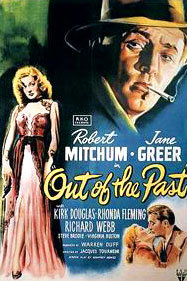
Media Communications - Genre , Film Noir

Noir=Dark
Dark rooms with light slicing through venetian blinds, alleys cluttered with garbage, abandoned warehouses where dust hangs in the air, rain-slickened streets with water still running in the gutters, dark detective offices overlooking busy streets: this is the stuff of film noir--that most magnificent of film forms--a perfect blend of form and content, where the desperation and hopelessness of the situations is reflected in the visual style, which drenches the world in shadows and only occasional bursts of sunlight. Film noir, occasionally acerbic, usually cynical, and often enthralling, gave us characters trying to elude some mysterious past that continues to haunt them, hunting them down with a fatalism that taunts and teases before delivering the final, definitive blow.
Most of these films were about crime, often murder, and the harsh would of private investigators, police detectives, and the criminals they seek. These films centered on " a world of darkness and violence, with a central figure whose motives are usually greed, lust, and ambition, whose world is filled with fear." The setting was almost always an urban one, with rain-slicked city streets reflecting neon signs in the night. The world presented in these films was almost always totally corrupt and devoid of any human sympathy. It was a world where "women with a past and men with no future" spent eternal nights in one-room walk-ups surrounded by the sounds of shots and sirens, of screams and sobs.
Out of the Past, for example, is one of the archetypal noirs, giving us a protagonist who has tried to escape his past (he betrayed a partner by running away with his girlfriend), but fate won't let him escape.
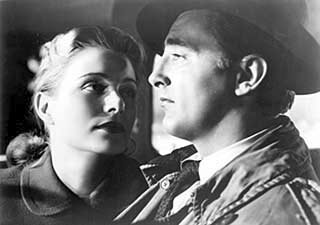
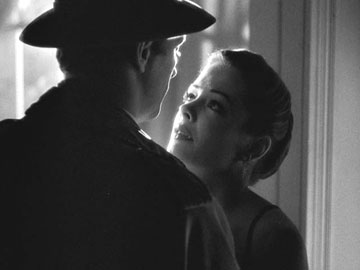
The Big Heat
Before she dies, Debbie heals Bannion, opening him up to feeling. "Remember how angry you got when I asked you about your wife," she says, and Bannion eloquently speaks about his past domestic life: "Kate was a sampler. She'd take sips of my drink and puffs on my cigarette--" Debby's death restores Bannion and our moral order, but Lang's ending is cautious and grim. Later, Bannion picks up the phone: there's a hit and run over on South Street. As he exits, we are reminded of the circularity of crime and its cost. A huge poster on the office wall reads, "Give Blood, Now." It seems that the women in this dark noir have given more than their fair share.
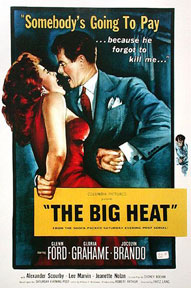
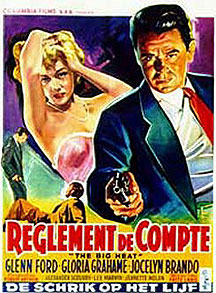
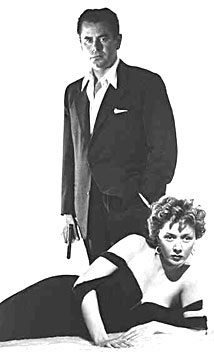
and Double Indemnity contains classic Noir elements, including short, clipped, witty dialogue full of double entendres (meanings):
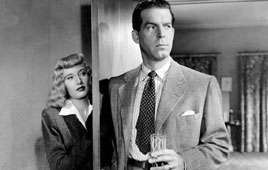
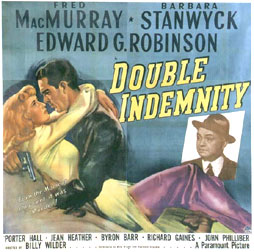
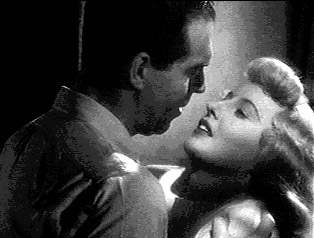
Phyllis: You from the Automobile
Club?
Neff: All Risk....
Neff: 8.30 tomorrow evening, then...
Phyllis: That's what I suggested.
Neff: Will you be here too?
Phyllis: I guess so. I usually am.
Neff: Same chair, same perfume, same anklet?
Phyllis: I wonder if I know what you mean...
Neff: I wonder if you wonder...
Neff: S'ppose I give you a ticket for speeding
Phyllis: S'ppose you give me just a warning
Neff: S'ppose it doesn't take...
++++++++++++++++++++++++++++++++++++++++++++++++++++++++++++++++++++++++++++++++++
FILMMAKING GROUP PROJECT
2 Groups
Graded as per specific role
This project is expected to be more refined and polished than previous ones,
building on all we have done so far. From storyboarding to abstract visuals,
all skills from previous projects should be employed and participation in the
group is absolutely necessary. Productive class meeting times are required.
Grades will be 25% Final Video and 75% Specific Role Requirements as stated
below. Each group meeting during class time will be observed and contributions/preparedness
noted for final grade.
Roles in the group should be delegated according to the strengths of the members;
if you're a good writer, you should write. If you're a good visual artist, you
should direct.
Chroma-keying is required in order to create an artificial sense of locations.
Footage from actual locations (not still images) will be composited with studio
shoots.
The Studio should be completely transformed to function as multiple sets for
both groups. Bring in whatever you need. Keep it neat and organized and don't
mix up the 2 groups stuff.
* Dressing the set is crucial... set a tone with details.
Roles & Responsibilities:
Director (1):
Create all storyboards from script. All shots should be pre-visualized. Must
direct actors. Must block out every scene and note on storyboards.
Writer (2):
Script with some stage direction.
Actors
Follow Directors directions. Work with writer for intent and fleshing out characters.
Set Manager/Props/Costumes/MakeUp (1):
Operate wipeboard during shoots and onhand during shoot for continuity. Collect
and organize all props and costumes needed on-set. Keep set neat and functional.
Camera (1):
In studio and on location. Take all visuals for location scouting to present to group. Work both cameras.
Audio/Toaster Operator (1):
Set up microphones, overdubbing, sampling- capture and tweak all audio. Work Toaster for live switching/capturing, following directions of Director.
Lighting (1):
Create own set of storyboards specific for lighting scene-by-scene. Set-up all lights, including studio ceiling and floor lights. Create masks for shaping light. Follow direction from Director.
Editing:
All need to be involved in post-production work.
Logs will be checked for grades.
Storyboards and notes must be followed.
Communication amongst group members is crucial.
Capture only what you need.
Follow folder-organization for clips!!!!!!!!
Your script must be school-appropriate.... sex and violence
should be alluded to with wit and image, not overtly.
Your script must contain the following elements, plus some of your own:
Character Types:
The Private Eye/Anti-Hero -
aggressive masculinity
dour nature
constantly poeticizing his life from a grim fatalistic pov
weak when it comes to sexy dames
hardened and cynical
Walter Neff: Do I laugh now, or wait 'til it gets funny?
The Femme Fatale -
uses her sexuality as a weapon, knowing no other way
trapped and desperate
The femme fatale is said to "never accept the role that society has chosen
for her"
hyper-conscious of her appearance (ie: Debbie and mirrors in The Big Heat)
fiercely independent and pays for it
sassy
"she embodies postwar fears that women, having contributed mightily to
the war effort and moved into "men’s work," might abandon the
domestic sphere entirely, causing all manner of social mayhem. She’s the
culmination of the self-consumed, anti-domestic, anti-social female"
The Good Woman -
too good
worth marrying
worth changing for (can this really happen?)
The Gangster -
violence covers up weakness
control issues.... psychotic? sociopath?
The Innocent -
crippled lady in The Big Heat
deaf&dumb boy in Out of the Past
Lola in Double Indemnity
The Patsy -
Gangsters right-hand man
competitive with the anti-hero... psychotic? sociopath?
The Plot Should Include:
Non-Linear Chronology -
flashbacks (a past and present that are inextricably linked)
voiceover (inability to escape fate, events being preordained)
the past’s death-grip on the present
Convoluted Crime Story -
a crime that presents a moral dilemma for the Anti-Hero
involves ppl who get murdered as plot thickens
no happy ending
Unlike the conventional detective or crime story, a film noir narrative revolves
around why there was a crime and not who committed it. In fact, we usually know
who committed the murder early on. The mystery is why. The perpetrator is almost
irrelevant-- but his motivation is not. The theme of a true noir is always a
moral dilemma brought about by someone who is either misleading himself, being
mislead by others, or both.
Car Scene -
fake background
lit from within car somehow
Fight Scene -
man on man
verbal taunts and threats
Scene of Brutality -
first attempt at murder fails
male violence on woman
innocents suffering
(cigarette burn/hot coffee in The Big Heat)
Visuals:
Lighting -
cryptic, shadowy, obscured, contrasty, gritty, paranoid
half-faces
revealed/lit eyes
dark rooms being entered
Camera -
off-balance, edgy, jagged
close-ups of lovers passion and desperation
Locations:
common spaces take on a sense of alienation
urban vs. rural/suburban
domestic(home) vs. crime dens
alleys, empty streets at night, phone booths,
public places where other ppl are going about daily livesIn-class Meetings:
Script development before writers hunker down.
Script read-throughs... rehearse, rehearse, rehearse.
Scene-by-Scene:
Location review.
Location review with gathered footage.
Props/set reviews.
Lighting reviews.
Audio reviews.
On-set rehearsals with blocking.
http://www.brightlightsfilm.com/27/bigheat1.html
http://www.brightlightsfilm.com/29/outofthepast.html